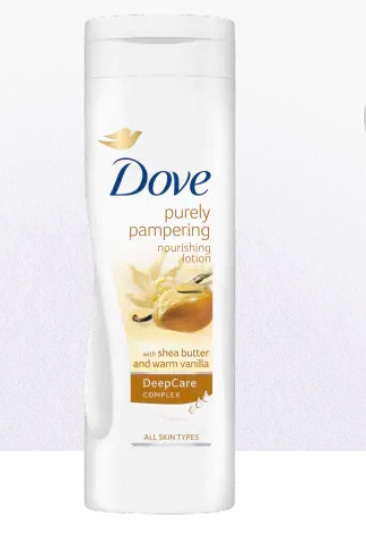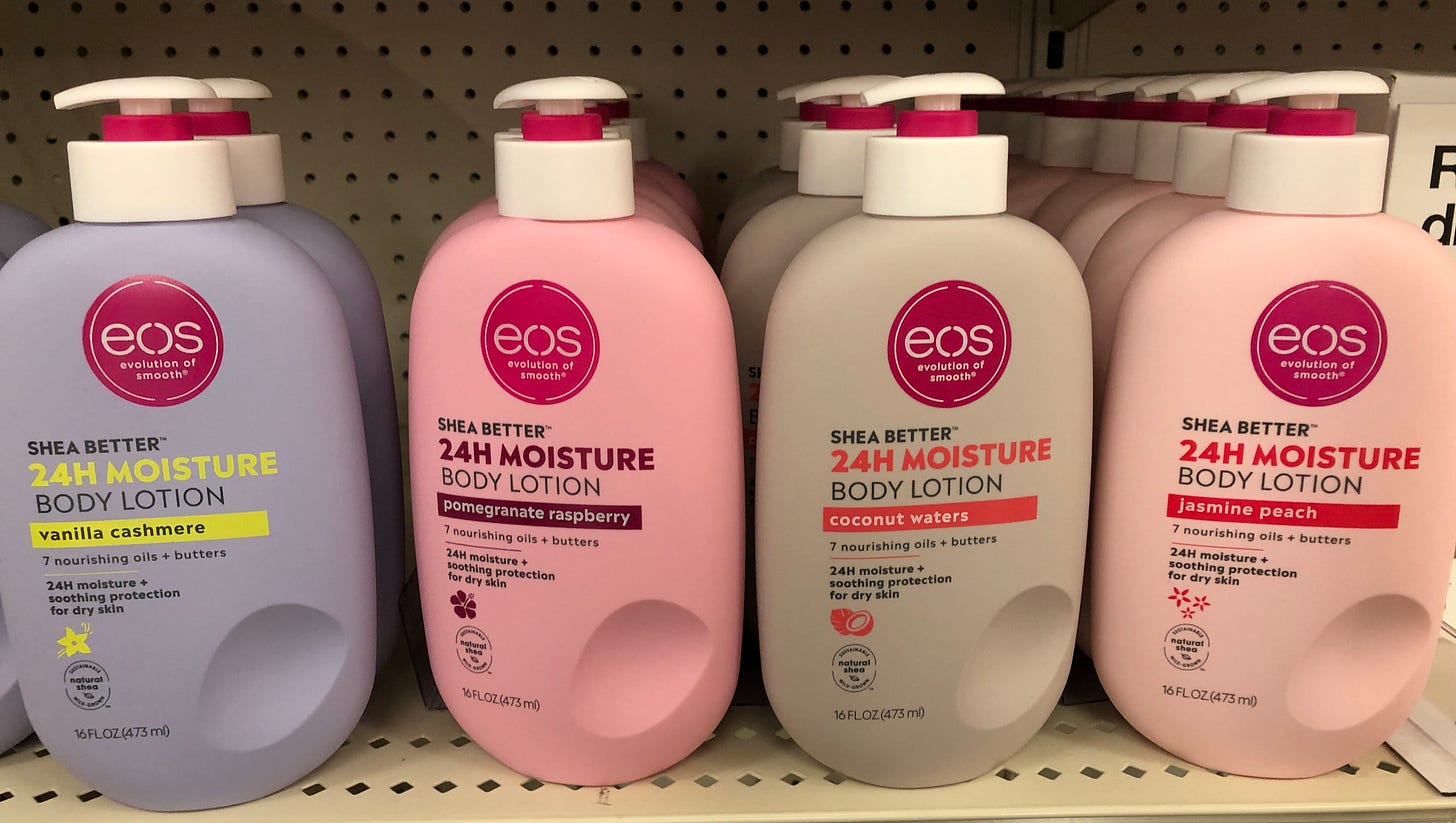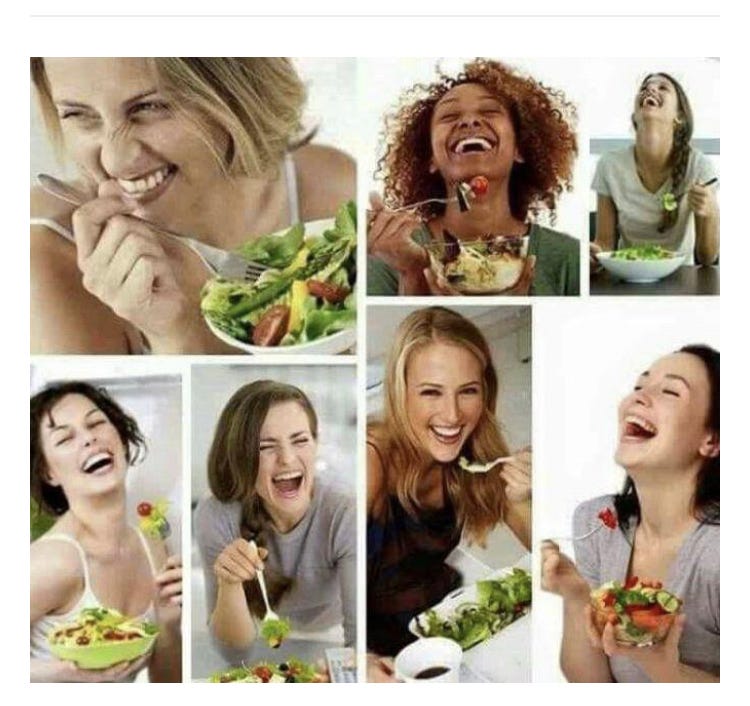Why Do Women's Beauty Products Smell Like Desserts?
How to Discover and Resist Hidden Ideologies
I first noticed a weird phenomenon many years ago when I bought this lotion:
“Warm vanilla” in a lotion that’s just sitting there on my bathroom shelf? How is that even possible? I have news for the folks at Dove: when you apply this lotion after a shower, it’s not warm, it’s COLD. But I digress.
My point is that I started noticing a similar phenomenon everywhere: the fragrances, names, and advertising for women’s beauty products seem designed to make us think of desserts. Don’t believe me? Check out these photos, from a recent excursion to Target:
Or this:

The Victoria’s Secret products depicted below cut out the middleman and promise to deliver sugar and Prosecco straight to us, as though we were all wine moms or perhaps Homer Simpson contentedly snacking on his five-pound bag of sugar.
I had a lot of fun collecting other examples of this phenomenon. Here are some representative products at the Body Shop (all product names and quotes come from their website): Almond Milk and Honey Body Butter;1 Vanilla Pumpkin Body Butter, which offers “warm, sweet baked pumpkin and notes of caramel, maple syrup and almond milk”; and Warm Vanilla Body Yogurt, “Made with vanilla extract from Madagascar, handcrafted Community Fair Trade shea butter from Ghana and Community Fair Trade organic almond milk from Spain.” Are you hungry yet?
Here are some more beauty product descriptions, this time from the website of Bath and Body Works: Vanilla Bean Noel Super Smooth Body Lotion is “A wintry sweet treat of fresh vanilla bean, sugar cookies, warm caramel, whipped cream and snow-kissed musk”; Winter Candy Apple is “A fruity, festive blend of candy red apple, winter rose petals, candied orange, maple leaf and fresh cinnamon”; Winter Peach Marshmallow is “A smooth, sweet blend of velvet peach, vanilla meringue and creamy jasmine”; and Christmas Cookies is “A sweet-as-sugar blend of creamy cookie dough, almond biscotti and caramel woods.”
I could go on, but it’s probably clear by now that something really weird is going on with these beauty products. There is no intrinsic, natural reason that beauty products should evoke desserts. In fact, I think these “desserty” products are a sign of a hidden ideology we ought to investigate.
Hidden Ideologies and How We Find Them
The term “ideology” has numerous definitions, but I use “ideology” to refer to cultural assumptions that might not be based in logic or fact, and that are used to justify actions that might not be good for everyone. Ideologies that are hidden are especially pernicious, because they perpetuate norms that can’t be questioned openly or even perceived. For example, doctors used to tell patients that smoking was good for them, the Marlboro Man linked smoking with masculinity, and Virginia Slims ads presented smoking as a way that women could assert their independence and empower themselves.2 Research into the health consequences of smoking, culminating in the Surgeon General’s warning, exposed this ideology as a dangerous lie.
How do we uncover and resist hidden ideology? A good start is to notice that a cultural assumption isn’t normal or natural but is in fact kind of weird, as we’ve just done with all those delicious beauty products. It can help to see whether the phenomenon occurs in other times or places. For example, as a Gen-Xer, I am old enough to remember a time when women’s beauty products smelled not like food3 but like flowers, musk, or citrus, and when ads promised that the products would sate not our hunger but rather our desire for sex, romance, and power. My fellow Gen-Xers will remember the cloying baby-powder smell of Love’s Baby Soft in its (in retrospect) disconcertingly phallic pink bottle. Gee, Your Hair Smells Terrific shampoo promised to attract men by wafting its fragrance their way. And my favorite, Jean Nate, boasted that its citrus perfume “gives you the feeling there’s NOTHING you can’t do” (including, apparently, winning the Kentucky Derby).
The apotheosis of 70s and 80s perfume-as-empowerment, though, has to be Enjoli. As a little kid, I thought the woman in the Enjoli commercial was the height of sophistication—although I didn’t quite comprehend what she meant by “and never let you forget you’re a man.” But notice that while she could “bring home the bacon and fry it up in the pan,” her perfume smelled like flowers, not like bacon!
Another way to spot a hidden ideology is to see whether the phenomenon is the same in all cases, or only occurs sometimes. In the case of women’s beauty products, it’s illuminating to contrast them with typical products for men, which don’t evoke dessert but are instead more practical or even badass. While I might not choose the “charcoal and clay” offering below for my shampoo (wouldn’t it just make your hair dirtier?), I can see the zingy appeal of caffeine and menthol, and who wouldn’t like to have hair that’s “thick and strong”?
Others products are just plain fun:
Honestly, wouldn’t you rather live in the world of the men’s products, where you can swagger around and wrestle with bears and a kraken? The women’s world of an endless buffet of sugary treats seems tame in comparison.
Once we’ve noticed that a phenomenon everyone accepts as normal is in fact weird, our next step is to figure out what has caused the phenomenon and whose interests it’s serving. To return to our cigarette example, the cultural norm that smoking was cool and healthy was devastating and even deadly for millions of people, but it did enrich shareholders in tobacco companies. Once the truth about cigarettes became public, it was much easier for people to resist the dubious allure of cigarettes.
So, to recap, we can discover and resist hidden ideologies through two steps:
Noticing that a phenomenon is not normal but instead is actually weird, and
Thinking about who benefits from the phenomenon, and who is hurt by it.
As it happens, I have a hypothesis for why women’s beauty products sound like desserts, but before I present it, let’s take a brief detour.
A Trip to the Land of Cockaigne
Numerous medieval authors and artists dreamed of the Land of Cockaigne, a paradise with an endless supply of delicious food, which they depicted in sensuous detail. Ben Jonson’s 1616 poem “To Penshurst” playfully alludes to this tradition of plentiful and easily acquired food, including fish and fowl that leap into the hunter’s arms, begging to be devoured:
The painted partridge lies in every field,
And for thy mess is willing to be killed.
And if the high-swollen Medway fail thy dish,
Thou hast thy ponds, that pay thee tribute fish,
Fat aged carps that run into thy net,
And pikes, now weary their own kind to eat,
As loath the second draught or cast to stay,
Officiously at first themselves betray;
Bright eels that emulate them, and leap on land
Before the fisher, or into his hand.
The folk song “Big Rock Candy Mountain,” written from the point of view of a Depression-era hobo, paints a similar picture of a paradise of readily accessible food:
In the Big Rock Candy Mountains
All the cops have wooden legs
And the bulldogs all have rubber teeth
And the hens lay soft-boiled eggs
The farmers’ trees are full of fruit
And the barns are full of hay
More soberingly, during WW2, as an alternative to military service, thirty-six conscientious objectors volunteered for a study on the effects of starvation on healthy adult men. The researchers, led by Ancel Keys, starved the men over the course of a year. The men were required to exercise vigorously and were fed as few as 1500 calories a day.4 Predictably, the men suffered depression and anxiety on this regime; in addition, they reported that they thought obsessively about food, talked about it constantly, fantasized about becoming chefs, read cookbooks for fun, and gazed longingly at people eating in restaurants.
Charlie Chaplin understood that hunger pangs cause us to be preoccupied with food; in this famous scene from The Gold Rush, a hungry Big Jim keeps imagining poor little Charlie as a nice juicy chicken. (Do check out the clip—Chaplin does a brilliant job of strutting and pecking like a chicken!)
What do all these examples have in common? In every case, people who are denied food, be they medieval peasants, victims of the Great Depression, or those on restrictive diets, will think about food constantly and obsessively. Even under normal circumstances, more than 90 percent of us experience food cravings, cravings that become all the more intense when we’re depriving ourselves of treats.
A Theory about Food and Beauty
I think you can guess where I’m going with this. Our puritanical culture is uncomfortable with anyone experiencing pleasure for its own sake, and we come down especially hard on women who might want to enjoy rich desserts (which could make us gain weight—the horror!). Diet culture presents desserts as sinful, and the mainstream media constantly reminds us that desserts are unhealthy. So a lot of us, in an effort to lose weight and/or eat healthily, avoid desserts—but continue to crave them. The creators and advertisers of beauty products may well have figured out that appealing to these cravings is an effective marketing strategy. If we can’t eat desserts, at least we can smell them—or, as Marie Antoinette might have said, “Let them smell cake!”
Our culture does, however, permit women to indulge ourselves in one way: it’s ok if we enjoy the process of making ourselves pleasing for other people to look at. Magazine articles praise women who go to the gym or the salon, TV shows and movies affectionately chuckle at women on yoga retreats or at the spa, and advertisers create absurdly didactic images of women thrown into ecstasies by salad. (I mean, I probably enjoy salad more than most people, but no salad has ever sent me into paroxysms of joy.)
Perhaps our culture considers all these desserty beauty products to be an acceptable substitute for actually eating dessert. People might not admire women who eat cotton-candy-pineapple-coconut concoctions and the like, but these products do allow us to smell dessert, think about it, and pretty ourselves up. And after all, who wouldn’t be tempted by “A sweet-as-sugar blend of creamy cookie dough, almond biscotti and caramel woods”?
How about you, readers? Have you ever noticed a phenomenon that was normal to everyone else but weird to you? What hidden ideology have you uncovered? Please share your thoughts in the comments!
The Tidbit
I am an advocate of desserts in our mouths and bellies, and not just smeared on our skin. This recipe comes from an assignment given out by a math teacher at my kids’ former school. The recipe is for eight servings, and students had to rewrite the recipe for four and twelve servings. A bonus arithmetic problem! And I can attest that making and eating this pudding is a lot more fun than using body lotion.
Chocolate Pudding
For the pudding:
1-1/2c heavy cream
1/2c sugar
1/3c cocoa powder
4tsp cornstarch
1/4tsp salt
1tsp vanilla
3 egg yolks
1/2c whole milk
For the whipped cream:
1c heavy cream
1tsp vanilla
1T sugar
In a medium, heavy saucepan, combine the sugar and cocoa powder and then slowly stir in the cream to remove the lumps. Heat on medium-high, stirring occasionally, until boiling.
Meanwhile, in a medium serving bowl, whisk together the cornstarch, salt, vanilla, and egg yolks until smooth, and then blend in the milk.
When the cream mixture is boiling, remove from heat, and, whisking constantly, slowly drizzle it into the egg-yolk mixture. (Be careful not to cook the egg yolks.) When the pudding is fully blended, return it to the saucepan.
Heat on medium, stirring constantly, until the pudding boils and thickens. Return it to the serving bowl, cool to room temperature, and refrigerate.
Shortly before serving, make the whipped cream: beat together the cream, vanilla, and sugar until stiff, spread on the pudding, and chill.
I recognize that I am not the Body Shop’s target audience, but I find the idea of “body butter” and “body yogurt” kind of icky.
Because I love the films of James Cameron, it gives me no pleasure to report that both Titanic and Avatar present smoking as a way for women to show their strength and independence and to stand up to the menfolk.
The sole exception I can think of from my childhood, Bonne Bell’s Lipsmackers, in fact proves the rule: all the other Bonne Bell products, e.g. Ten-O-Six lotion, had a strong, almost repellent medicinal odor.
Note that the calorie count of the starvation diet is still 25 percent higher than the 1200 daily minimum calories many current diets recommend.










I worked in advertising and brand strategy for 20 years. I still only think in terms of marketing, as most of my friends would agree. It's fun, but I have always recognized the dark side of it. I worked on a new product that was truly barrier-shattering: a condom for men, targeted to women to help them protect their sexual health (bigger than pregnancy prevention and more powerful). It was a product idea from Trojan sprung from two insights: 50% of their target audience was the "recipient" of the product and could influence purchase and men don't want to use condoms (that's not the insight) but we phrased it this way in our meetings "if she gets it (the condom), he gets it (sex)" and men WOULD wear condoms if women simply asked them to, because they wanted sex vs. no sex. But women don't know much about condoms except that we've been told men don't like them. And since (another insight) "every man a women sleeps with has the 'potential' to be 'prince charming' -- in many cases -- women don't want to screw it up by asking men to do something that might be cause for rejection. I tell you -- this was so fascinating. The most interesting project I ever worked on. I analyzed loads of data and conducted focus groups all over the US. Did you know that in the South at that time (around 2005/6) focus group recruiters in the South wouldn't let us recruit for groups of women "unmarried, living with partners for x time". We had to phrase the screener as "engaged" or "seeing someone steadily for x time". Crazy. But I digress. There is so much more to this story that fits your writing. The creatives launching the product were inspired by Virginia Slims advertising. We wanted women to not be afraid of taking charge of their sexual health. We did a lot of work to get the line of products stocked in the femhy aisle, vs. the condom area perceived as full of leering men. We provided instructions. We did borrow packaging from perfume/cosmetics. But we had the first black packaging in the femhy aisle -- before Kotex did it. The product was called Alexa. (so much learning about chick name stereotypes in THAT process.) It died because, wait for it, Walmart refused to stock it because, again, in the South, it was perceived as "too promiscuous" or, as one sales director told me, "You're just asking for women to bend over and hike up their skirts." Seriously. To my face. The good news is that shortly after, Play brand of condoms and lubes was launched and Millennials took over and the marketing world and life evolved. But I still feel sorry for women who get divorced, especially at my age (60) and don't know how important it is to protect their sexual health. You can find the digital ad we created for Alexa on YouTube. :-)
Mom, I hate to break it to you.... citrus is also a food